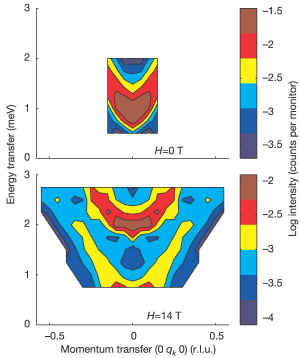Abstract of Publication No. 453
 Ch. Rüegg, N. Cavadini, A. Furrer, H.-U. Güdel, K. Krämer, H. Mutka, A. Wildes, K. Habicht and P. Vorderwisch
Ch. Rüegg, N. Cavadini, A. Furrer, H.-U. Güdel, K. Krämer, H. Mutka, A. Wildes, K. Habicht and P. Vorderwisch
Bose–Einstein condensation of the triplet states in the magnetic insulator TlCuCl3
Nature 423, 62-65 (2003)
![]()
![]()
Abstract:
Bose–Einstein condensation denotes the formation of a collective quantum ground
state of identical particles with integer spin or intrinsic angular momentum. In
magnetic insulators, the magnetic properties are due to the unpaired shell
electrons that have half-integer spin. However, in some such compounds
(KCuCl3 and TlCuCl3), two Cu2+ ions are
antiferromagnetically coupled to form a dimer in a crystalline network: the
dimer ground state is a spin singlet (total spin zero), separated by an energy
gap from the excited triplet state (total spin one). In these dimer compounds,
Bose–Einstein condensation becomes theoretically possible. At a critical
external magnetic field, the energy of one of the Zeeman split triplet
components (a type of boson) intersects the ground-state singlet, resulting in
long-range magnetic order; this transition represents a quantum critical point
at which Bose–Einstein condensation occurs. Here we report an experimental
investigation of the excitation spectrum in such a field-induced magnetically
ordered state, using inelastic neutron scattering measurements of
TlCuCl3 single crystals. We verify unambiguously the theoretically
predicted gapless Goldstone mode characteristic of the Bose–Einstein
condensation of the triplet states.